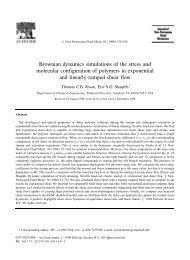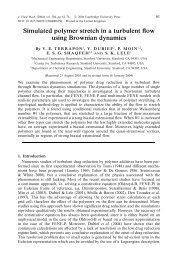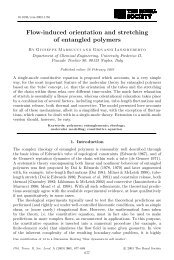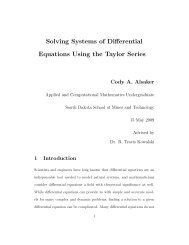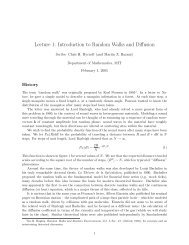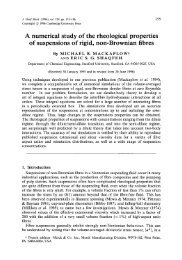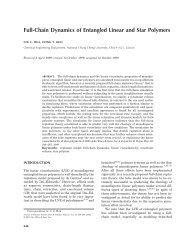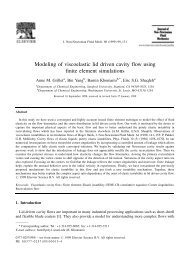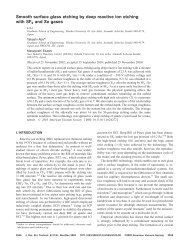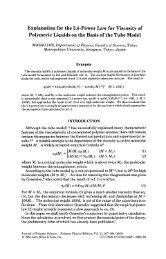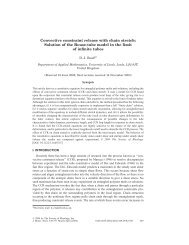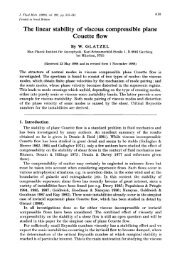Molecular modelling of entangled polymer fluids under flow The ...
Molecular modelling of entangled polymer fluids under flow The ...
Molecular modelling of entangled polymer fluids under flow The ...
You also want an ePaper? Increase the reach of your titles
YUMPU automatically turns print PDFs into web optimized ePapers that Google loves.
1.4. DEFORMATION KINEMATICS 3<br />
10 5<br />
Newtonian Viscosity<br />
10 4<br />
η 0<br />
(t)<br />
σ xy / γ . [Pa-sec]<br />
10 3<br />
Hooke’s Law<br />
10 2<br />
10 -2 10 -1 10 0 10 1<br />
time [sec]<br />
Figure 1.1: Transient shear viscosity <strong>of</strong> a <strong>polymer</strong> melt at low shear rates compared to<br />
a perfectly viscous liquid and an ideal elastic solid.<br />
1.4 Deformation kinematics<br />
Before attempting to derive a constitutive equation the deformation history imposed<br />
on the material must be defined. <strong>The</strong> response <strong>of</strong> a material depends on the geometry<br />
<strong>of</strong> the imposed deformation, therefore an adequate mathematical description <strong>of</strong> the<br />
deformation is essential. One way to achieve this is to specify the velocity field, v,<br />
imposed by the deformation on a material element at point r. However, only relative<br />
motion <strong>of</strong> material points are relevant, hence the velocity gradient tensor, κ<br />
≈<br />
, is usually<br />
a more relevant measure,<br />
κ (r, t) = (∇v(r,<br />
≈ t))T . (1.1)<br />
If κ<br />
≈<br />
does not depends on spatial position r then the <strong>flow</strong> is deemed a simple <strong>flow</strong>. A<br />
range <strong>of</strong> useful <strong>flow</strong>s such as shear and extension fall <strong>under</strong> this definition.<br />
Simple<br />
<strong>flow</strong>s are also more easily analysed theoretically and so data on these <strong>flow</strong>s is relatively<br />
abundant and reliable. In this thesis I will test constitutive models <strong>under</strong> simple<br />
<strong>flow</strong>s against experimental data as a prerequisite to <strong>under</strong>standing more complicated<br />
deformations.<br />
constitutive equations.<br />
<strong>The</strong> tensor κ<br />
≈<br />
is widely used to define the deformation in differential<br />
An alternative description <strong>of</strong> the deformation is the deformation gradient tensor,<br />
E<br />
≈<br />
, which relates the vector connecting two embedded points before the deformation,<br />
X, and after the deformation, X ′ ,<br />
X ′ = E.X. (1.2)<br />
≈<br />
<strong>The</strong> deformation gradient tensor is more commonly used in integral constitutive equations<br />
or to describe step deformations. Care must be exercised in the use <strong>of</strong> E since it<br />
contains information not only about the stretching caused by the deformation but also



